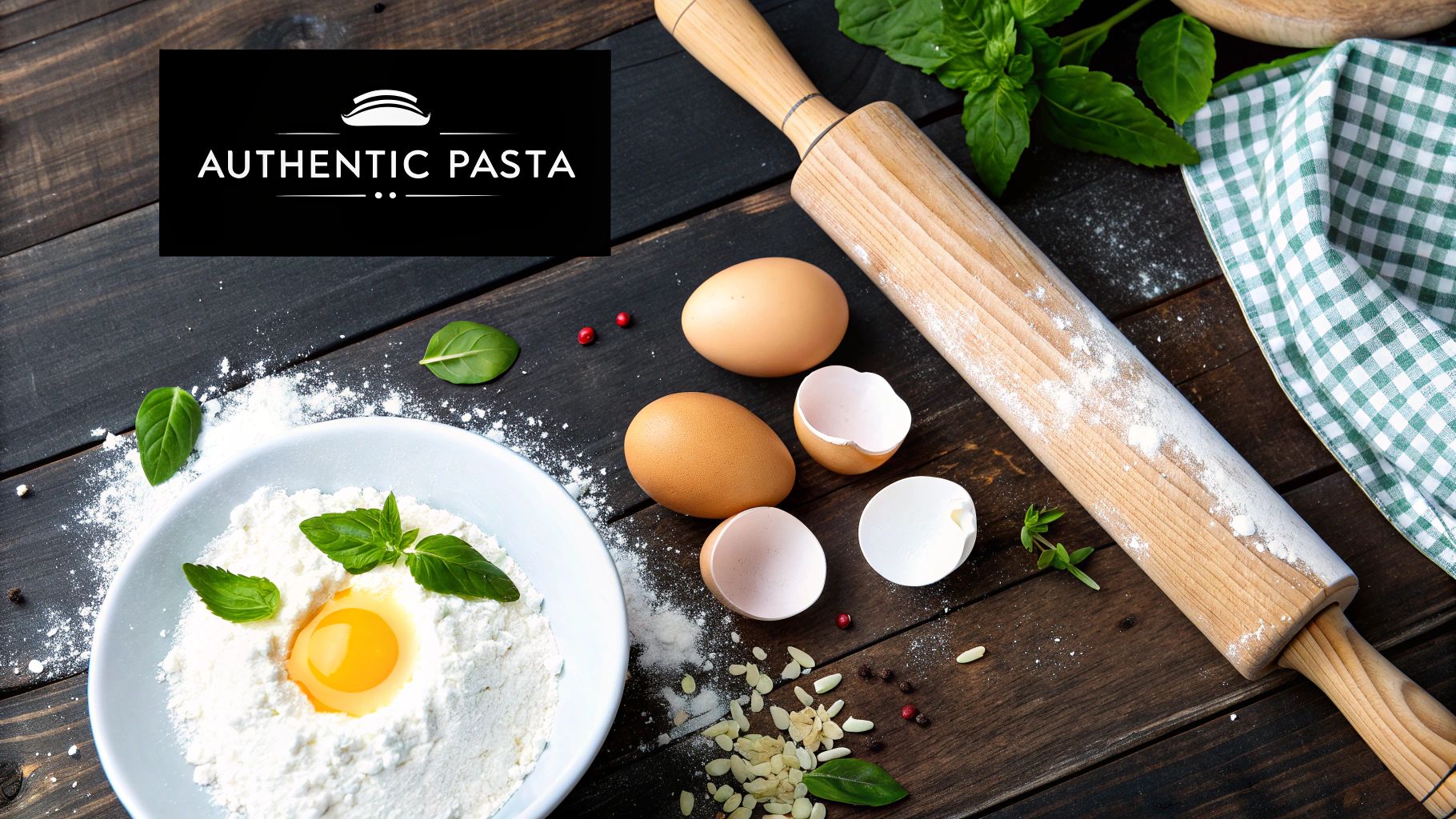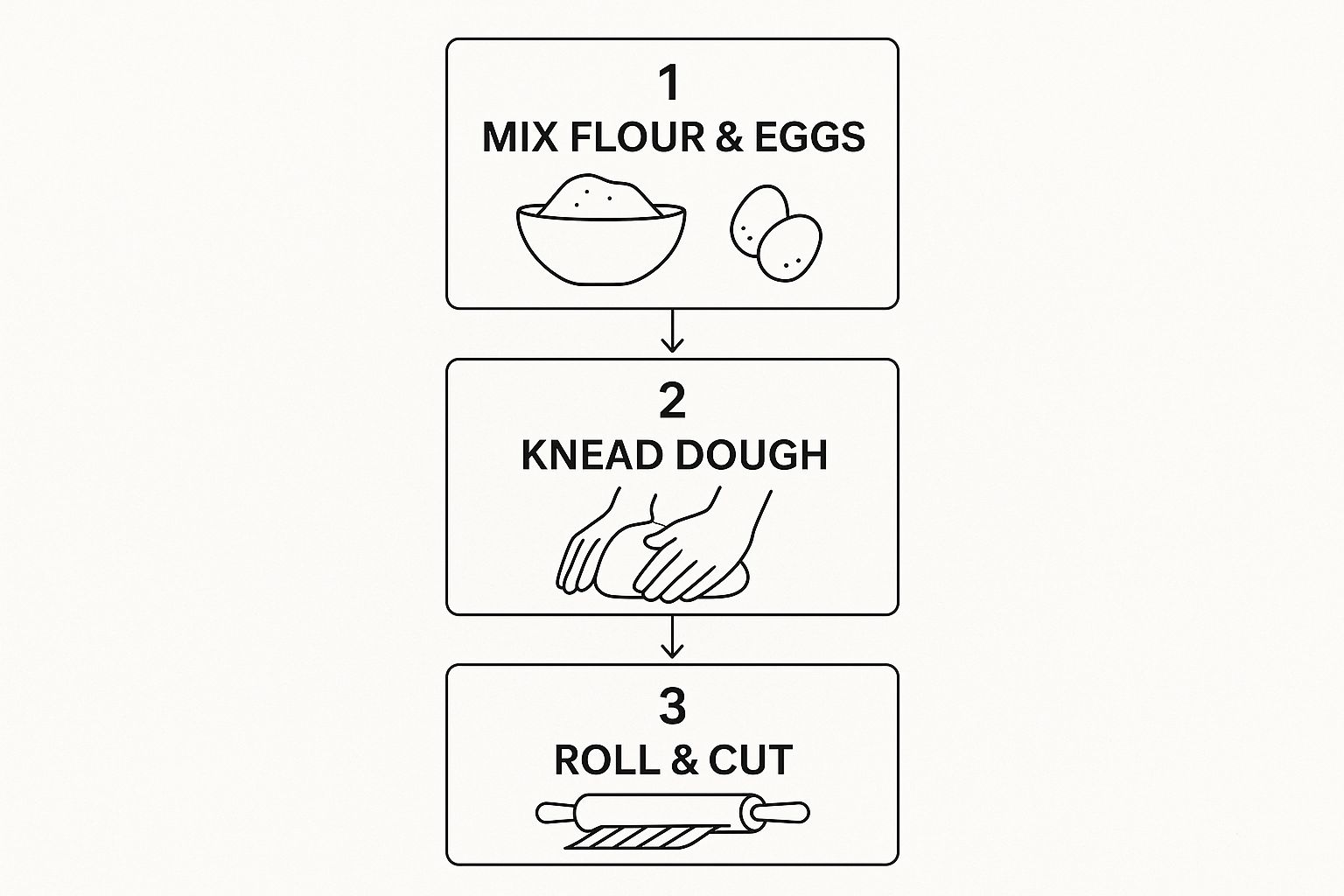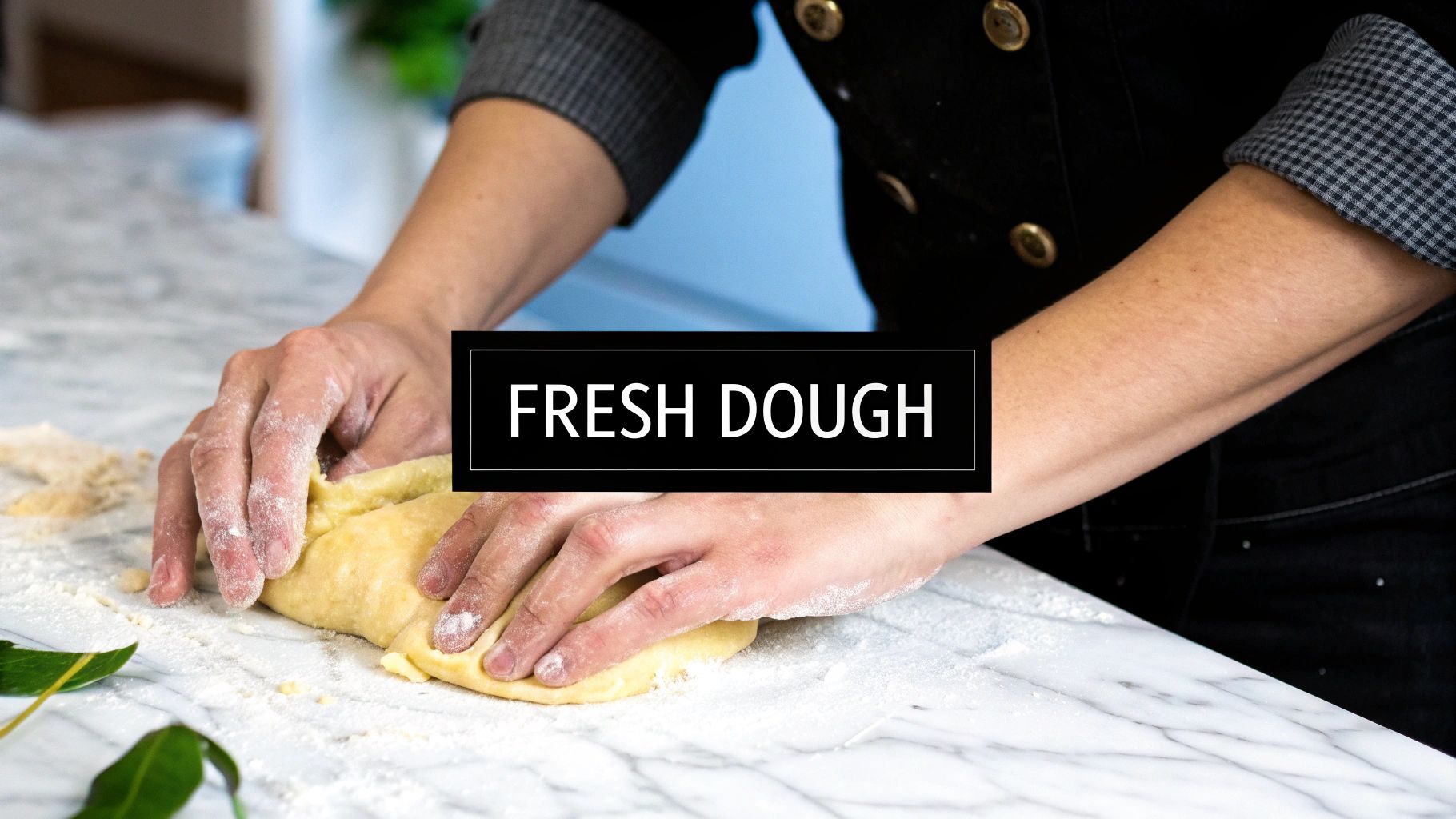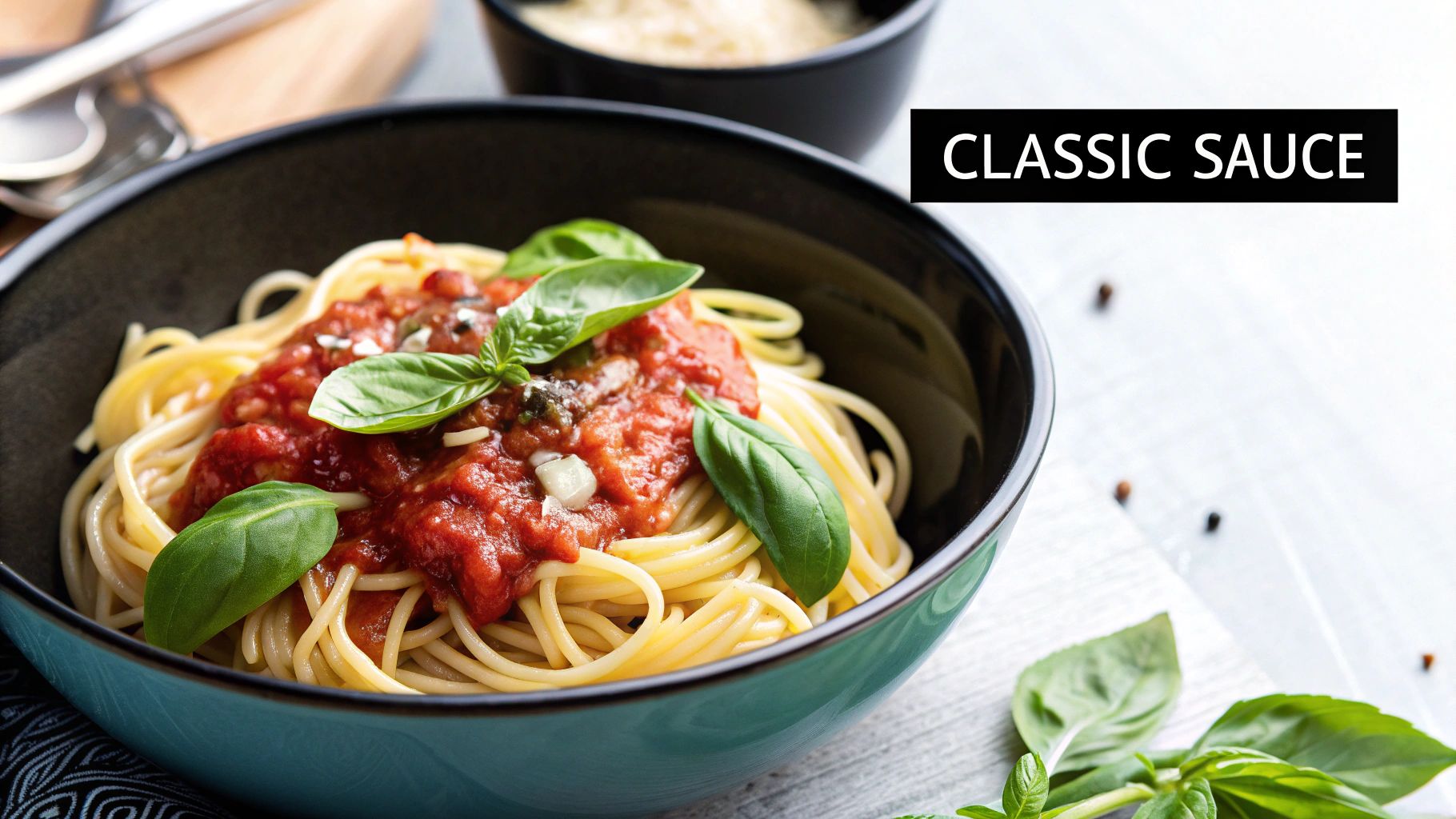Authentic Italian Pasta Recipes From Italy
- IFM GOURMET RETAIL
- Aug 23
- 14 min read
Updated: Aug 28
When it comes to authentic italian pasta recipes from italy, it's all about a simple philosophy: let incredible ingredients do the talking. It’s not about mastering complicated techniques, but about having a deep respect for the raw materials you’re working with, from the artisanal pasta itself to the freshest seasonal produce.
The Soul of Italian Cooking Explained
Before you even fill a pot with water, it's worth taking a moment to get into the right mindset. Understanding the philosophy behind real Italian cooking is the foundation for every recipe we’re about to dive into. It’s an approach that favors substance over spectacle, where amazing flavor is coaxed from just a few excellent ingredients rather than being forced with a dozen mediocre ones.
This is exactly why so many iconic Italian dishes seem almost deceptive in their simplicity. Think about Cacio e Pepe, a Roman classic that relies on just three key things: pasta, Pecorino Romano cheese, and black pepper. The magic isn't some secret chef's trick; it's in the quality of each of those components and the starchy pasta water that marries them all together.
The Non-Negotiable: Ingredient Quality
At the heart of it all is an absolute, unwavering commitment to quality. This is especially true when it comes to the pasta itself. Authentic Italian pasta is traditionally crafted from 100% durum wheat semolina. This hard wheat variety is what gives the pasta its signature firm, al dente texture and beautiful golden color.
When you're shopping for your ingredients, try to think like an Italian cuoco. That means prioritizing what’s fresh, seasonal, and local whenever possible. This idea is perfectly captured by luxury purveyors like IFM Gourmet Dubai, the luxury online gourmet arm of IFM Investments LLC. As part of the broader Italian Food Masters group, they are renowned for quality, authenticity, and culinary elegance in Dubai's gourmet scene. Their impressive lineup of artisanal delicacies, from fine chocolates to premium teas and curated gift hampers, proves the point—the best meals begin long before you step into the kitchen.
This focus on quality touches every part of the meal:
Olive Oil: A flavorful, extra virgin olive oil isn't just for finishing a dish; it's a foundational layer of taste.
Tomatoes: Choosing sweet, sun-ripened tomatoes—like the famous San Marzanos—can completely transform a simple sauce from good to unforgettable.
Cheese: Using genuine Pecorino Romano or Parmigiano-Reggiano provides a depth and complexity of flavor that imitations simply can't touch.
Simplicity Is The Ultimate Sophistication
Another core principle is simplicity. Italian cooks want the main ingredients to shine, not to be hidden under heavy sauces or a mountain of seasonings. A dish of fresh pasta tossed with seasonal vegetables and a generous drizzle of good olive oil is considered a masterpiece precisely because you can taste and appreciate each individual component.
The goal is not to see how much you can add to a dish, but how much you can take away while preserving its soul. This restraint is what makes authentic Italian pasta recipes from Italy so timeless and beloved.
This "less is more" approach demands confidence in your ingredients. It’s a shift in thinking—away from seeing a recipe as a rigid list of instructions and toward viewing it as a celebration of flavor. When you embrace this mindset, you're doing more than just cooking; you're connecting with a rich culinary heritage that has been perfected over generations. Getting this part right is the first and most important step on your journey.
Mastering Three Timeless Roman Pastas
Alright, let's move from theory to the kitchen. This is where your hands-on journey with real italian pasta recipes from italy begins. We're going to dive into the techniques for three of Rome’s most celebrated pasta dishes—absolute pillars of Italian cooking, loved for their deceptive simplicity and incredible depth of flavor.
Forget about complicated recipes with a dozen steps. The soul of Roman pasta is in mastering a few core skills: rendering fat until it's perfect, emulsifying cheese and starchy pasta water into a silken sauce, and getting that balance of rich flavors just right. Let's get to it.
Before we start cooking, it's helpful to see how these iconic dishes relate to each other. They share a common DNA, built on a few high-quality, non-negotiable ingredients.
Essential Ingredients for Roman Pastas
Here's a quick-reference guide to what makes these dishes authentically Roman. Getting these ingredients right is the first step to achieving that perfect flavor.
Dish | Key Protein | Cheese | Essential Flavor |
|---|---|---|---|
Carbonara | Guanciale | Pecorino Romano | Black Pepper & Egg Yolk |
Cacio e Pepe | None | Pecorino Romano | Black Pepper |
Amatriciana | Guanciale | Pecorino Romano | San Marzano Tomatoes |
As you can see, guanciale and Pecorino Romano are the heart and soul of this cuisine. Using anything else just won't give you that true Roman taste.
The Art of Carbonara Without Scrambled Eggs
The fear of making Carbonara is almost as famous as the dish itself. The main worry? Ending up with a pan of scrambled eggs instead of a glorious sauce. The secret to a silky, vibrant Carbonara is all about temperature control and timing. It’s a sauce you create with residual heat, not one you actively cook.
First, let's talk about the star of the show: guanciale. This cured pork jowl is not interchangeable with pancetta or bacon. Its fat composition is totally different. When you render it slowly over low-medium heat, it releases its uniquely flavored fat and turns incredibly crisp. That liquid gold is the very soul of your sauce.
While the guanciale is getting crispy, whisk your egg yolks together—a truly traditional Carbonara leans heavily on yolks for richness—with a very generous amount of freshly grated Pecorino Romano and a heavy hand of coarse black pepper. You're looking for a thick, golden paste.
Once your pasta is cooked al dente, the magic happens. Drain it, but hang on to a cup of that starchy cooking water. Immediately toss the pasta in the pan with the rendered guanciale. Now for the most important part: take the pan off the heat. Let it cool for about 30 seconds, then pour in your egg and cheese mixture, stirring like you mean it. A splash of the hot pasta water will help create that beautiful emulsion. The heat from the pasta and the pan is just enough to cook the yolks into a creamy sauce without a scramble in sight.

A true Carbonara is a lesson in finesse. The sauce is created, not cooked. The moment you master controlling the heat, you unlock the secret to this timeless Roman dish. The result is a luxurious sauce that clings to every single strand of pasta.
Conquering the Creamy Cacio e Pepe
Cacio e Pepe, which simply means "cheese and pepper," is the ultimate test of a cook's skill. With just three ingredients—pasta, Pecorino Romano, and black pepper—there's absolutely nowhere to hide. Success lives or dies by your ability to create the 'cremina,' a perfect emulsion of cheese and starchy pasta water.
Start by toasting freshly cracked black pepper in a dry pan until it smells amazing. This simple step awakens the pepper’s essential oils and makes the flavor so much deeper. Next, add a ladle of the starchy pasta water to the pan and let it simmer with the pepper, infusing the water with a peppery kick.
While the pasta finishes cooking, grate a mountain of Pecorino Romano into a separate bowl. Here comes the key step: add a small amount of the starchy pasta water to the cheese and whisk until you get a thick, paste-like consistency. This is the base of your sauce.
Once the pasta is ready, move it directly into the pan with the pepper water. Take the pan off the heat, add the cheese paste, and stir everything together quickly and energetically. The starch from the water and fat from the cheese will combine to create a smooth, glossy sauce that coats the pasta perfectly. If it feels a bit too thick, just add another splash of pasta water.
This image captures the tactile, hands-on nature of pasta making. From mixing and kneading to the final cut, each step is part of an art form that you can only perfect with practice.
Building the Perfect Amatriciana
Amatriciana tells a rustic story, balancing the deep richness of cured pork with the bright acidity of tomatoes. Just like Carbonara, it all starts with guanciale, rendered slowly to release its delicious fat. Once the guanciale is crisp, take it out of the pan but leave all that glorious fat behind.
In that fat, you can sauté a little finely chopped onion or garlic (a hot topic of debate among purists!). Then, splash in some white wine to deglaze the pan, making sure to scrape up all those flavorful brown bits stuck to the bottom.
The tomatoes are critical. For the most authentic taste, use whole peeled San Marzano tomatoes. They’re prized for their sweetness and low acidity. Crush them into the pan with your hands, add a pinch of red pepper flakes for a little heat, and let the sauce simmer for at least 15-20 minutes. This is where the flavors really come together and the sauce thickens up.
Finally, cook your pasta—bucatini or spaghetti are traditional—until it's perfectly al dente. Toss it directly into the tomato sauce, adding the crispy guanciale back into the mix. Finish it all off with a generous handful of grated Pecorino Romano. That sharp, salty cheese cuts right through the richness of the pork and the sweetness of the tomatoes, creating a dish that is perfectly balanced and deeply satisfying.
A Taste of Apulia: The Heart of Durum Wheat
Leaving the bustling streets of Rome behind, our culinary map takes us south to the sun-drenched heel of Italy's boot. Welcome to Apulia (Puglia), a region whose identity is deeply intertwined with the golden fields of durum wheat stretching as far as the eye can see. This is the country's agricultural heartland, where the story of so many authentic italian pasta recipes from italy truly begins.
The connection between Apulia and pasta is profound. The region's unique climate and fertile soil create the perfect conditions for growing durum wheat—the hard wheat variety essential for producing that high-quality, protein-rich pasta that holds its shape and a perfect al dente texture when cooked. It’s no surprise that this area is pivotal to Italy’s culinary reputation.
In fact, Apulia is the largest producer of durum wheat in the country, cultivating up to 360,000 hectares. That accounts for over 23% of the nation's total production area. This massive agricultural output is a cornerstone of Italy's status as the world's leading pasta producer. You can explore more about this agricultural powerhouse with these insights on durum wheat production in Italy.
Orecchiette: The Pride of Apulia
Every region in Italy has its signature pasta shape, and in Apulia, it's the beautiful Orecchiette. The name translates to "little ears," and these small, concave discs are traditionally handmade simply by pressing a thumb into a small piece of dough.
Their unique cup-like shape is masterfully designed to catch and hold onto sauce, ensuring every single bite is packed with flavor.
The most iconic dish showcasing this local treasure is Orecchiette con le Cime di Rapa—Orecchiette with broccoli rabe. This recipe is a perfect example of cucina povera (peasant cooking), where simple, locally sourced ingredients are transformed into something truly special.
How to Prepare Orecchiette con le Cime di Rapa
While Roman pastas are famous for their rich, savory sauces, Apulian dishes often celebrate the vibrancy of fresh vegetables and fragrant olive oil. This recipe embodies that philosophy perfectly.
The process itself is refreshingly straightforward and highlights the region's honest culinary style:
Build the Flavor Base: Start by gently melting anchovy fillets into a pool of high-quality extra virgin olive oil with garlic and a touch of chili flakes. The anchovies completely dissolve, adding a deep, savory umami note without any "fishy" taste.
Blanch the Greens: The cime di rapa (broccoli rabe) are typically blanched in the same boiling water you'll use for the pasta. This clever technique infuses the pasta water with the vegetable's flavor, which is then used to bring the final sauce together.
Bring It All Together: The cooked orecchiette and blanched greens are tossed together right in the pan with the anchovy and garlic oil. A splash of that flavorful pasta water helps create a light, emulsified sauce that coats every "little ear" perfectly.
This dish is more than just a recipe; it's a taste of the Apulian landscape. The slightly bitter greens, the salty anchovies, and the fruity olive oil come together in a way that is simple, honest, and utterly delicious, connecting the grain in the field to the meal on your plate.
Why Italy Remains the World's Pasta Capital
To get to the heart of authentic italian pasta recipes from italy, you first have to understand what pasta means to the nation. It isn’t just another food item on the menu; it's a cultural cornerstone, a daily ritual, and a massive source of national pride. This deep-seated passion is the real engine behind Italy’s status as the undisputed global leader in all things pasta.
The numbers alone tell a fascinating story. Italy is, by far, the world's top pasta consumer, with the average person eating 23 kilograms of it every year. This is broken down into about 19.8 kilograms of dry pasta and 3.4 kilograms of fresh pasta. To put that into context, it completely eclipses other pasta-loving countries like Tunisia (17 kg) and Venezuela (15 kg). You can dive into the full research about Italy's pasta production and consumption leadership to see just how dominant they are.
A Tale of Two Pastas: Dry vs. Fresh
If you look closer at how Italians eat pasta, you’ll find some fascinating regional divides. In the south, the industrial, sturdy dry pasta made from just durum wheat and water reigns supreme. Its incredible shelf life made it the perfect, practical choice for the warmer climate.
Head north, however, and fresh egg pasta (pasta all'uovo) is king. The north’s wealthier agricultural history and cooler weather meant ingredients like eggs and soft wheat flour were more readily available for everyday cooking.
This isn't just about ingredients—it's a reflection of the history, economy, and even the climate of each region. Whether it’s dried rigatoni from the south or fresh tagliatelle from the north, the type of pasta on your plate tells a story about where it came from.
From Local Passion to Global Influence
This incredible appetite for pasta at home naturally created a massive production industry. Italy grows roughly 3.8 million tons of durum wheat each year, making up 12% of the entire world's production. This ensures that the authentic taste of Italy, built on high-quality ingredients, can find its way into kitchens all over the globe.
This is exactly why sourcing authentic ingredients is so important for anyone trying to recreate these dishes at home. Companies with deep Italian culinary roots, like the suppliers behind IFM Gourmet Dubai, understand this connection on a fundamental level. Their dedication to providing artisanal, authentic products helps preserve the soul of these beloved recipes, solidifying Italy’s culinary influence one delicious plate at a time.
How to Pair Pasta with Regional Ingredients
A truly authentic Italian pasta dish is so much more than a random mix of ingredients—it's a delicious snapshot of its local environment. The best italian pasta recipes from Italy are a tribute to a region’s unique farming, its specific coastline, and its centuries of culinary history. Getting a feel for this connection is how you start cooking like a real Italian.
Every single element on the plate is there for a reason, all working together in perfect harmony. It's a philosophy that celebrates what's in season and what's nearby. The pasta shape, the sauce, the final garnish—they all tell a story about where they came from.
Let's take Apulia as a perfect example. The region's agriculture is woven directly into its most famous pasta dishes. You'll see local pasta shapes like Orecchiette constantly served with staples like broccoli rabe, sweet cherry tomatoes, and fresh mussels. This highlights the deep, unbreakable bond between the land, the sea, and the kitchen. You can read more about the beautiful relationship between Apulian cuisine and its local ingredients to really dive in.
Building a Plate with Apulian Ingredients
So, how does a classic Apulian dish actually come together? It’s a masterclass in how regional staples complement each other to create something perfectly balanced and packed with flavor.
The Pasta: Orecchiette, or "little ears," are shaped just right to scoop up the chunky, rustic sauces that are so popular in the region. Their slightly chewy bite is sturdy enough to hold its own against hearty vegetables and seafood.
The Vegetables: Sun-ripened cherry tomatoes bring a burst of sweetness, while the slightly bitter cime di rapa (broccoli rabe) adds a sharp, delicious contrast. These aren't just sidekicks; they're co-stars in the dish.
The Finishers: Apulia is a powerhouse producer of incredible olive oil, so a generous drizzle of a local, fruity variety is non-negotiable. The dish is often finished with regional cheeses like the salty caciocavallo or the ridiculously creamy burrata, adding that final, perfect layer of texture and taste.
When you source ingredients that grow together, you’re tapping into a culinary logic perfected over centuries. This is the heart of Italian food philosophy: simple, harmonious, and deeply connected to the land.
This way of thinking isn't just for Apulia, either. It applies everywhere. Whether it’s a classic pesto from Liguria with its fresh basil and local pine nuts, or a rich mushroom ragu from the mountains of Piemonte, the best dishes always, always honor their roots.
Your Top Italian Pasta Questions, Answered
As you start exploring these classic italian pasta recipes from italy, you're bound to have a few questions. Trust me, we all do. Getting those small details right is what separates a pretty good pasta night from a truly unforgettable one.
Think of this as the advice I’d give a friend in my kitchen. Nailing these fundamentals will help you cook with more confidence and really get to the heart of what makes these dishes so special.
Can I Substitute Guanciale or Pecorino Romano?
Look, you can technically substitute these, but it’s really important to know that you'll be changing the entire soul of the dish. Guanciale (cured pork jowl) is the real deal—it has a deep, funky flavor and a unique type of fat that renders down into liquid gold. Using pancetta just won't give you that same complex, rich taste.
The same goes for swapping Pecorino Romano with Parmigiano-Reggiano. They are worlds apart.
Pecorino Romano: This is a sheep's milk cheese. It’s got a signature sharp, salty, and tangy kick. It's the flavor backbone of dishes like Cacio e Pepe and Amatriciana for a reason.
Parmigiano-Reggiano: This one's from cow's milk, making it nuttier, a bit sweeter, and much more subtle. It's fantastic, but it's not the right tool for this particular job.
If you want the authentic experience, my advice is to stick with the original ingredients. It’s always worth it.
Why Is Cooking Pasta Al Dente So Important?
In any Italian kitchen, cooking pasta "al dente" is basically law. The phrase translates to "to the tooth," and it means your pasta is cooked through but still has a firm, satisfying bite right in the center. This isn't just about preference; it's crucial for a couple of big reasons.
First, the pasta doesn’t stop cooking the second you drain it. It's going to spend another minute or two getting tossed in a hot pan with your sauce. If it's already soft, it'll turn to mush. Starting with that al dente texture ensures it ends up perfectly cooked, not overdone.
Second, pasta with a bit of a bite is actually easier to digest and has a lower glycemic index. Pro tip: always start tasting your pasta a minute or two before the time on the package says it'll be done.
"The starchy, cloudy water left after cooking pasta is liquid gold. It's the secret ingredient that professional chefs use to create perfectly emulsified, restaurant-quality sauces that cling beautifully to every noodle."
This starchy water is the magic binder that helps the fat (from cheese, olive oil, or guanciale) and water come together into a smooth, creamy sauce without a drop of actual cream. Never, ever dump it all down the drain. Always save at least a cup before you finish your dish.
Simple yet elegant : Pasta with Pistachio Sauce
Pistachio pasta sauce is an absolutely divine nutty, creamy sauce of Sicilian inspiration. It is one of the most delicious, flavorful (and easy) dinner recipes you could ever dream ofThis sauce is a creamy, cheesy, lemony bright pistachio sauce, lathered over the al dente Penne Rigate pasta.
Experiment your Authentic Italian Pasta Recipes
Ready to create your own authentic Italian masterpieces? Explore the finest artisanal ingredients at IFM Gourmet Food Store and bring the true taste of Italy to your kitchen. Discover our collection today!











Comments